Terraforming is the process of changing the global environment of a planet in such a way as to make it suitable for human habitation. Because it is so far beyond our current technological capabilities, most articles about terraforming have been written by science fiction writers rather than scientists. For example, there is an entry for a terraformed Venus in the science fiction work “Encyclopaedia Galactica” which is set thousands of years in the future.
Originally a hot dry greenhouse world, (Cytherian Type) with an atmosphere consisting mostly of carbon dioxide with a surface pressure 94 times greater than that of Earth. The planet was shrouded with clouds of sulphuric and hydrochloric acid and the mean surface temperature was 480 C, making the world extremely hostile to terragen and carbon-based life. Because of this the planet was sparsely populated for many thousands of years; recently it has been successfully terraformed.
(Kazlev et al 2006).
So far there has been very little detailed scientific research on terraforming Venus. Most papers on terraforming have focussed on Mars. Even so, there is no reason why – given enough resources and time – an advanced human civilisation would not be able to terraform Venus.
It has to be said at this point that the international willingness to commit to a project like this is much harder to imagine than the existence of the technical ability to do so. There would have to be fundamental changes in the way in which human beings work together on a global scale, and the conditions of life for the whole of humanity would have to be considerably better than they are now, were such vast amounts of time and money to be committed to a project like this.
However, setting that aside, it is interesting to consider the various challenges to making Venus habitable, so that humans can live and work on the planet without any need for protective equipment, such as space suits or oxygen supplies.
.
What a terraformed Venus might look like – Image from Wikimedia Commons
High Temperatures and Pressures.
The surface temperature of Venus is around 500 degrees Celsius and the atmospheric pressure is a crushing 92 times that of the Earth. The atmosphere consists of 97% carbon dioxide (Williams 2015), a powerful greenhouse gas which traps the Sun’s heat. In order to make the planet habitable the surface temperature would need to be around 0 to 35 degrees and the atmospheric pressure similar to that on the Earth.
One way to cool Venus would be to build a giant sunshade to block most of the Sun’s rays from hitting the planet. This was described in detail in a paper written by the late British science writer Paul Birch (1991).
The shade would orbit the Sun at a specific point about 1 million km above the planet’s surface called the L1 Lagrange point, shown as L in the diagram above (see note 1). It would need to be slightly larger than the diameter of Venus, 12,100 km, to fully shade the planet. The cost and technological challenge of building such a shade would enormous. It would need to be 100 billion times larger in surface area than the International Space station, shown below, which is the largest object ever built in space.
It is likely that such a shade would be built up from thousands or even millions of smaller individual shades and would take many decades to complete from start to finish. As the shade neared completion, and most of the Sun’s rays were blocked from hitting the planet, the surface of Venus would begin to cool. Interestingly, when the shade was complete, because Venus would no longer be lit up by the Sun, to an observer on Earth Venus would go from being the third brightest object in the sky (after the Sun and the Moon) to being invisible.
After about 100 years the temperature of Venus would drop to 31 degrees (see note 2). At this temperature, known as the critical point of carbon dioxide, some of the carbon dioxide in the atmosphere would start to condense from gas to liquid and the low-lying areas of the surface of Venus would begin to be covered in seas and oceans of liquid carbon dioxide, in the same way that much of the Earth’s surface is covered by seas and oceans of water. As it condensed into liquid, the amount of carbon dioxide left in the atmosphere would start to fall and with it the atmospheric pressure.
Eventually the temperature would drop to the freezing point of carbon dioxide (-57 degrees) and the seas, oceans and lakes of liquid carbon dioxide would begin to freeze. Much of the remaining carbon dioxide in the atmosphere would fall as snow.
This entire cooling process would take hundreds of years from start to finish. When it had completed the next step would be to ensure that when the shade was removed, allowing the planet to warm up, the frozen carbon dioxide wasn’t released back into the atmosphere. One way this could be achieved would be to cover up the frozen carbon dioxide oceans with an insulating material and provide some sort of refrigeration system to keep it cool. Once the carbon dioxide was safely locked away the sunshade could then be removed to allow the planet to warm up again. Because nearly all the carbon dioxide would have been removed from the atmosphere it would no longer provide such a powerful greenhouse gas.
No Water
Venus is a very dry planet. Its atmosphere contains only a small trace of water and there is no water on its surface. By comparison, on Earth 71% of the planet’s surface is covered by water and there are about 1.39 billion cubic kilometers of water on the planet. The breakdown of how this water is distributed is shown in the tables below (U.S. Department of the Interior 2015)
As water is essential for life, it would be necessary to import water to Venus to make the entire planet habitable for plant and animal life. A lot of water would be needed, but it would not be necessary to have most of the planet covered with deep oceans of water. Probably around 30-50 million cubic kilometres of water would be sufficient. Even so, this is a still a huge amount of water to shift.
How could we get a large amount of water to Venus?
It would undoubtedly be necessary to import a huge amount of water to Venus to make the entire planet habitable for plant and animal life, but it would not be necessary to have most of the planet covered with deep oceans. Probably around 30 million cubic kilometres of water (roughly 2% of the amount found on Earth) would be sufficient.
There various ways of transporting this water to Venus. One obvious option would be to transport the water from the seas and oceans of Earth by cargo-carrying spacecraft. One cubic kilometre of water weighs one billion tonnes, so 30 million cubic kilometres of water weighs 30 thousand trillion (30,000,000,000,000,000) tonnes. If we had a massive fleet of one thousand spacecraft, each of which could carry a payload of one thousand tonnes would need 30 billion missions to carry this amount of material. This is clearly not feasible!!
Another possibility would be to transport only hydrogen, and not necessarily from the Earth. A water molecule consists of two hydrogen atoms and one atom of oxygen, but the latter is sixteen times heavier than a hydrogen atom. The mass of material taken to Venus would therefore be reduced by 90%. Water could be produced by chemical reaction of the transported hydrogen with the remaining carbon dioxide in Venus’s atmosphere. The hydrogen could be created on Earth by splitting water molecules into their component elements, or it could be sourced elsewhere. For example, it could be collected by scooping it up on an orbiting ring from the atmosphere of one of the giant planets in the outer Solar System and transporting it to Venus by spacecraft. Regardless of where the hydrogen is sourced, this method of providing Venus with water would still be prohibitively expensive.
A fascinating alternative way of getting all the water needed to Venus was suggested in Birch’s paper. It involves moving one of Saturn’s ice moons into orbit around Venus and then breaking it up, thus releasing all the water needed onto the planet.
Saturn has a number of ice moons such as Hyperion (shown below), an irregularly shaped object 360 by 260 km which consist mainly of ice, covered in a thin layer of rock.
Image from NASA
The proposal is that we could build a huge structure on Hyperion which would use the Sun’s heat, concentrated by mirrors, to put out a jet of steam into space in the same direction as it orbits Saturn. This is shown in the diagram below.
This jet of steam will provide a force which will gradually slow down Hyperion in its orbit causing it to gradually spiral inwards towards Saturn. After about 30 years Hyperion will be in an oval-shaped orbit which will cause it to pass close to the giant moon Titan.
Titan is much larger than Hyperion and the near collision between the two objects will give Hyperion so much speed that it will be ejected from orbit around Saturn. If the speed and angle are just right, after it escapes from Saturn it will be on a path which will take it close to the giant planet Jupiter. This technique is known as a slingshot and NASA uses it to send spacecraft to the outer Solar System.
As Hyperion passes Jupiter, the giant planet’s gravity will hurl it into the inner Solar System. If the angle of approach to Jupiter is just right it will be possible to send it on such a path that it will approach Venus slowly enough to be captured by Venus’s gravity and go into orbit around the planet. Once in orbit Hyperion would be gradually broken up and its water transferred to the planet’s surface.
Although this somewhat convoluted plan might appear to be something out of an exotic science fiction story, it obeys all the laws of physics and could potentially be achieved by an advanced human civilisation which devoted the resources to do it.
No oxygen
In order to be habitable Venus would need a similar level of oxygen in its atmosphere to that on the Earth. On Earth oxygen makes up about 21% of the atmosphere, whereas Venus’s atmosphere has almost no oxygen. Compared to the other challenges this would be relatively easy to resolve. The oxygen concentration could be increased by plant life which, uses a process called photosynthesis to convert carbon dioxide and water into carbohydrates and oxygen.
Image from Wikimedia Commons
Long day/night cycle
On Venus the slow rotation of the planet means that a day lasts 116.8 Earth days. Most Earth lifeforms would struggle to adapt to such a long day/night cycle. A shorter day could be created by means of orbiting shades and mirrors.
No magnetic field
On the Earth its magnetic field forms a protective shield around the planet which protects its surface from electrically charged particles from the Sun (the solar wind) and from outer space (cosmic rays). Without a magnetic field there would be an increased risk of cancer for anyone who ventured outdoors for any significant period of time. To make Venus completely habitable it would need to be given an artificial magnetic field. I will discuss this in a later post
I hope you have enjoyed this post. To find out more about the Science Geek’s blog, click here or on the Science Geek Home link at the top of this page.
Post updated and revised 5 November 2018
Notes
1) At this point the shade would orbit the Sun in exactly the same time, 224.7 days, that it takes Venus to orbit the Sun. Therefore it would always be shading the planet once it was put in place.
2) Any timescales here should be treated as very approximate. The actual values depend on the properties of the Venusian atmosphere during the cooling scenario.
References
Birch, P. (1991) Terraforming Venus quickly, Available at:http://www.orionsarm.com/fm_store/TerraformingVenusQuickly.pdf (Accessed: 6 February 2016).
Kazlev, M.A., Sandberg M., Bowers, S., Parisi M (2006) Encyclopaedia Galactica -Venus, Available at: http://www.orionsarm.com/eg-article/48e7ce77477af (Accessed: 11th February 2016).
U.S. Department of the Interior (2015) How much water is there on, in, and above the Earth?, Available at: http://water.usgs.gov/edu/earthhowmuch.html (Accessed: 7 February 2016).
Williams D R (2015) Venus fact sheet, Available at:http://nssdc.gsfc.nasa.gov/planetary/factsheet/venusfact.html (Accessed: 6 February 2016).


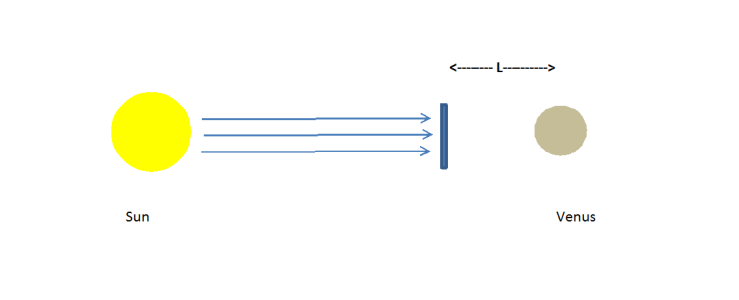
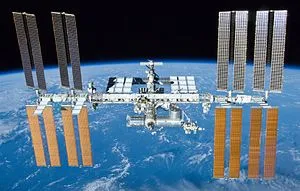
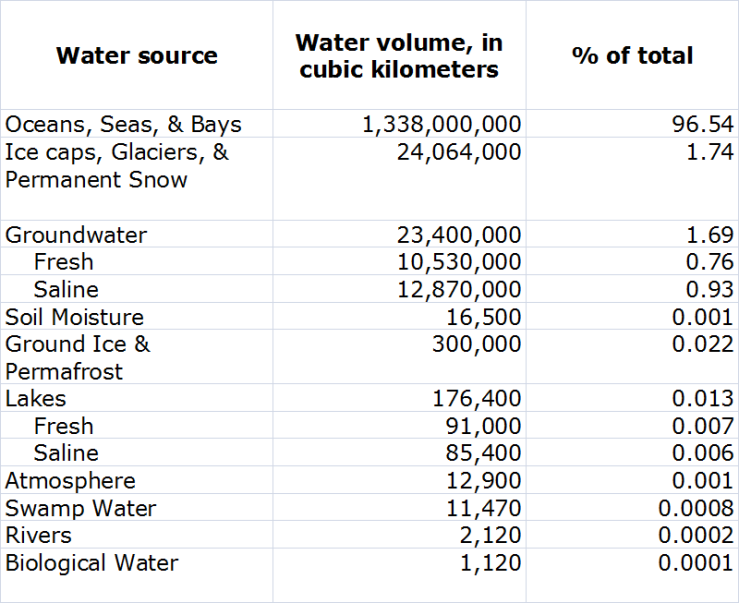
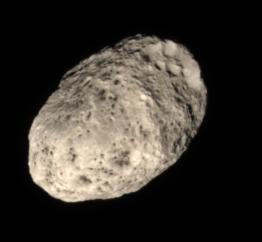

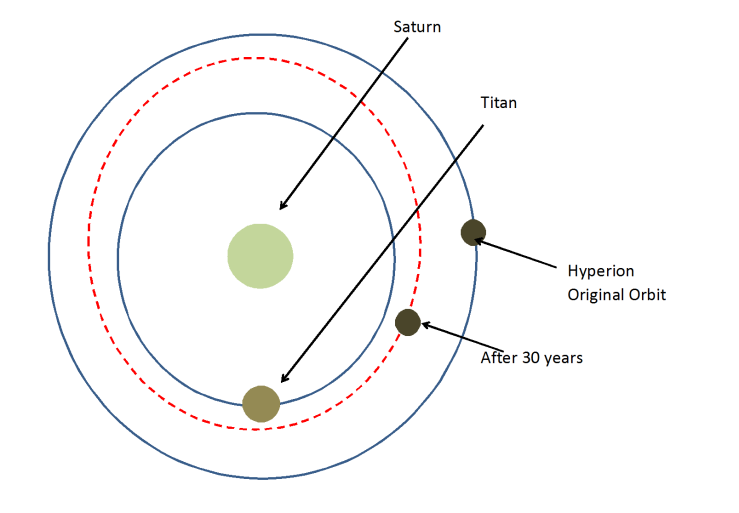

Hi Steve,
Best of luck tackling the ‘mag field’ problem! I’m afraid I can’t make any contribution that has a reasonable prospect of working.
However I think we’ve glossed-over a significant – but far more prosaic – problem: the sun-shield. It’s planet-size, and if its mass is to be remotely manageable, it would need to be of paper-thin material; say, aluminum foil or plastic film with a sprayed metal coating, comparable to the JWST primary mirror.
Radiation pressure can safely be neglected in a small object (like an international space station), but not in a 12000 km disk. If it’s not to be pushed away from the L1 point it will need to be equipped with low-power thrusters.
If we have a very large, but very flimsy, object whose position needs adjusting, there will need to be a number of thrusters. A (very) rough calculation suggests that we’d need at least one per kilometre – which means that about a hundred million of them might be adequate.
An object like this that has to move slightly is basically unstable & has a very strong tendency to crumple – which would drastically reduce its shielding power. To ensure that that doesn’t happen, all the thrusters need to be very delicately co-ordinated, otherwise the shield is likely to become either torn, or crumpled, or poorly distanced, or poorly oriented (i.e. no longer normal to a direct line to the Sun).
The signal-processing system in the SKA will combine the signals produced by about 5000 antennas (when it’s finally working!) and it’s complex for several reasons, but it’s simple compared with this one. Also we need to consider how long the shield has to keep working. I suspect that the thrusters are likely to have run out of propellant far too soon, despite the amazing 29th century technology.
Regards, David.
LikeLike
Hi David,
Thank you very much for your interesting observations
LikeLike
Terraforming Venus
Hi Steve,
Further to the “Mag Field” problem: I suggest the following. You might not think much of it but it’s the best I can propose …
A few centuries from now we’ll no doubt have developed the capability to confidently manipulate large asteroids. We need two, each at least the size of a large mountain. We place them on a collision course with Venus, and they’re both travelling in paths within the ecliptic but in opposite directions.. One of them moving in, say the “East-West” direction just hits Venus at a tangent. The second one, moving in the “W-E” direction hits the opposite edge of the planet tangentially at around the same time..
The planet will now have acquired a new spin axis, and if we’ve got all the navigation right, its alignment of the axis will be in the most useful orientation i.e. roughly at right angles to the ecliptic.
Also, Venus’s crust and mantle will now have acquired a spin relative to its (mainly iron, mainly liquid) core, and an appreciable dynamo effect will be created, and hence an external field.
We were aiming to cool Venus down; unfortunately the above will heat it up considerably. Never mind: we’ll now deploy the sun-shield, but will have to wait rather longer for a viable surface temperature. But when that happens, we’ll choose another asteroid with the right composition to dump a useful amount of water onto the surface or the atmosphere.
Epilogue:
On contemplating the amount of work involved, we might well decide to delegate the whole project to the Vogon Constructor Fleet – or one of its partners (by that time we’ll no doubt be able to communicate with them or their associates!), who’ll make short work of the minor job.
But alas, there’s likely to be a problem: the Vogons may take a passing glance at Earth, and observe an incredibly overpopulated planet, most of whose inhabitants contribute nothing except to ensure an even more damaged & polluted world than there was before. The visitors might decide that a major terror-forming operation was called for.
Regards, David.
LikeLike
Hi David,
If you are short of something to read on terraforming Venus you might want to look at my e book which describes how Venus might be terraformed
LikeLike
Recently it was said that Venus was the first planet to harbor life as we know it. If that was the case, then Mercury was Venus satellite. For Venus to be habitable, its rotation had a 24hr Earth rate of over 1000 mph. A fast rotation on its axis would allow Venus to lock on Mercury, thereby generating a strong magnetic field.
What caused Venus to become a planet with a runaway greenhouse effect? The answer is another planet crashed into it, thereby slowing down its rotation to 243 Earth days per full rotation. This would have caused Venus to lose its ability to hold on to its satellite Mercury. With the lost of its magnetic field (due its slow rotation) the temperatures on Venus began to boil over, like a pot with hot water that’s not moving. This is the reason why Venus lost Mercury. There is evidence that Mercury was formed from Venus when it was first impacted by another planet. Thus Mercury was created from Venus as the the Earth’s moon was formed from a similar event.
To terraform Venus will require speeding its axis rotation at twice the speed of Earth’s. This would allow the planet to shut down its runaway greenhouse effect. This would allow for Mercury to become Venus satellite once again, that would allow it to generate a strong magnetic field. Also, Venus clockwise rotation is really the planet upside down.. In addition, the planet’s axis tilt must move from 177 degrees to 24 degrees for Venus to produces the 4 seasons…
LikeLike
If a magnetic field is created in the process it may negate the effects of trying to shed the atmosphere.
LikeLike
I once did some back of envelope calculations to see what the magnitude of the problem was. I won’t bore you with the numbers but just give you the results. It you fling 90% of the atmosphere of Venus away from the planet at a trajectory parallel to the equator at escape velocity the momentum exchange will spin the planet in the other direction resulting in an increase of the Venusian day to 3 Earth days. The energy required to do such a thing in 100 years would require a 100% efficient solar cell array 5 times the diameter of Venus. Obviously I’m assuming 100% efficiency of energy to momentum transfer to get an upper limit. Your results may vary. My idea was to turn Venus into a giant high voltage homopolar motor by firing an electron bean at one of the poles and a neutralizing proton beam at the edge of the atmosphere create a pinwheel of ionized atmospheric particles that will form around the equator. The magnetic field necessary to do such a thing was one of the big uncertainties. Would the system create it’s own self sustaining magnetic field? And open question. Matter for the solar cell, the electron-proton accelerator and the reaction mass could be obtained from asteroids and comets. The nice thing is that all of the machinery is space based which will keep people and equipment safe from the deadly effects of the current Venusian surface environment. Obviously a BIG project but who said terraforming a planet is easy.
LikeLike
An interesting idea. You should start a blog and expand in more detail 😉
LikeLike
Resently i found out Russia and china use high powered radiowaves to super heat and destabalize the ionosphere. The one’s used increase the ionosphere several hundred degrees. Used to possible disrupt communication in the future. That may also work to terraform venus from several solar powered satelites rotating around venus. As venus ionosphere may act like a magnetic field. Once this happens it may shed the atmospere willingly. If not combine xray lasers, microwaves and high intensity lasers. All combined coyld work.
LikeLike
An idea to terraform venus might be to use several solar or nuke or both powered laser satellites angled just right in order to cook off excess atmosphere or disrupt its ionosphere. To shed more of its atmosphere into space or some other reaction with lasers. Once cool enough. Turn off lasers. Possibly until needed again. Water by damaging a comet near its orbit around sun it’ll pick up water and debris each time it goes around sun. Then send down some tanks of water that were on the laser satellites. Fast track a probe carrying airborn micro organisms to hopefully stabilize the rest of the toxic atmosphere and go from there.
LikeLike
An interesting idea
LikeLike
If not lasers possibly microwaves or xrays or some of both or all. Anything best to cook off enough of its atmosphere to start the terraforming process. Tell your friends
LikeLike
one more point for the Saturn ice moon plan…if any future medium-advance-since-today civilization is able to move such amount of materials from earth to saturn orbit, or building an orbital twice-venus-size sunshade into space, is not easy to accept that they would reach nuclear fusion reactor/engine??, well, looks like this big ice rock is the perfect fuel station for such a reactor…maybe won´t be that hard to move Humungus quantities of H2O in 50-100 years in the solar system?anybody agree?
LikeLike
[…] Terraforming Venus describes how in the future we could alter Venus to make it more Earth-like so that we could live on the planet without needing any special protective equipment. […]
LikeLike
[…] Terraforming Venus describes how in the future we could alter Venus to make it more Earth-like so that we could live on the planet without needing and special protective equipemnt . […]
LikeLike
I love this kind of thing! I would really recommend the novel 2312 by Kim Stanley Robinson. Humans have populated most of the solar system (including asteroids) and there are some really detailed (and scientifically viable) descriptions of terraforming. A lot of the techniques mentioned in this post are actually used on Venus in the book, like the sunshield and CO2 snowstorm!
LikeLike
Thanks,
I will add this book to my “books to read” list
LikeLike
Terrific to think about – even just one aspect like moving an ice-moon is mind boggling. Great post.
LikeLike
Thank you and it is all perfectly possible for an advanced civilisation given enough resources.
The Science Geek
LikeLiked by 1 person
It always comes down to – not can “we” [someone] do it – but, do we want to do it badly enough? 🙂 Great post to get the brain cells pumping.
LikeLike
A very intriguing process. Too bad neither of us will be around to see it happen. How would you repair our atmosphere if you had the resources? I really enjoy your imagining the future.
LikeLike
Thanks for your comment. I think that terraforming Venus is likely to happen. Obviously that neither of us will be around to see it ;-). It won’t occur for a long long time in the future. The first step will be to build permanent colonies in space, Moon and Mars and possibly Mercury (which has ice near its poles).
LikeLike
Very interesting to consider these possibilities, at first it all seems the stuff of fiction rather than something that could become a reality, albeit over many centuries. However most of it is a large scale extension of what has already been done in the few short years of human space travel that has occurred in the lifetimes of people like me who were born before the first excursions made by humankind into space.
Specifically, the construction of a large shield to block Venus from the sun’s rays is, as you say, similar to the space station, but on a massive scale. Also the use of the gravitational fields of other planets to slingshot objects into space or other orbits has already been done many times. However I would think it would be long time before the funding, technology and human resources to do all this are available – I would like to see the business case for terraforming venus! A couple of observations:
Venus is much closer to the sun than the earth – could it really cool down to the extent suggested? Ad surely the sun would be a massive dazzling presence to any humans who may eventually set foot on its surface?
Also – it seems that what s happening on earth at present is a process of reverse terraforming – CO2 and other greenhouse gases proliferating in the atmosphere with climate change now a reality – and over a very short period of time relative to the terraforming schedule you describe for Venus – what would the earth be like in 500 years time if things continue as they are? There may even be a mass extinction which could render our attempts to escape this world futile.
In the meantime I await with interest your post about creating an artificial magnetic field on Venus – a challenge indeed! Thanks
LikeLike
Hi GrahamD,
Thanks for your comment.
I will try and answer some of your questions.
Venus is much closer to the sun than the earth – could it really cool down to the extent suggested? Yes it could given enough time if the shade bocks the Sun’s rays efficiently.
surely the sun would be a massive dazzling presence to any humans who may eventually set foot on its surface? Yes that it true but an advanced civilisation would be able to finely tune the temperature so that the planet didn’t overheat
LikeLike
So, a modified dyson sphere, or hemisphere?
LikeLike
It would certainly be possible live under large dome like structures on the surface on Venus, once the surface temperature and pressure had been adjusted to more Earth-like values. This might well be an intermediate approach before the planet was fully terraformed
The Science Geek
LikeLike
The theories behind terraforming might well have practical uses for this planet so I agree the ideas are worth pursuing for no reason other than that.
LikeLike
Very true !
LikeLike
Is there a way to liberate hydrogen or water chemically from materials already available on Venus – perhaps below the surface? Importing it from another planet sounds incredibly inefficient.
LikeLike
I think the issue is that there is very very little hydrogen on Venus. The lack of magnetic field has meant that when water molecule photodissociate any hydrogen escapes into space
LikeLike
I meant hydrogen locked in other compounds, perhaps in solid form? Even if a lot of energy was needed to convert it into hydrogen gas, it would surely be far less than importing it from outside?
LikeLike
You make an interesting point
On Earth, other than in water, most hydrogen is found is organic molecules or hydrated salts and minerals such as gypsum (CaS04.2H20). On Venus there are virtually no organic compounds and I would imagine than the high temperatures on Venus would ensure that there are no hydrated salts.
There is of course some hydrogen in the sulphuric acid clouds which shroud the planet but the total amount of hydrogen in these clouds is small compared to what would be needed to make the planet habitable.
LikeLike
Really immense technical and logistical challenges. It is depressing how hard it is to get people to pay attention to our own planet Earth, let alone Venus or Mars. Still, these issues need thought and people to analyze the possibilities. You never know what will come out of that thinking.
LikeLike
I agree. Terraforming Venus is more the stuff of science fiction, but there are no fundamental laws of nature preventing an advanced enough civilisation which was able and wiling to devote sufficient resources from achieving it.
LikeLiked by 1 person
Great article! I wonder if you could take the frozen CO2 from Venus and seed it into the Martian atmosphere to try to start raising the temperature there? That would likely be as cost prohibitive as moving water from Earth to Venus, with the added difficulty of preventing it from freezing right out of the atmosphere before it could do any good. Looking forward to how you tackle the mag field problem!
LikeLike
Thank you
LikeLike